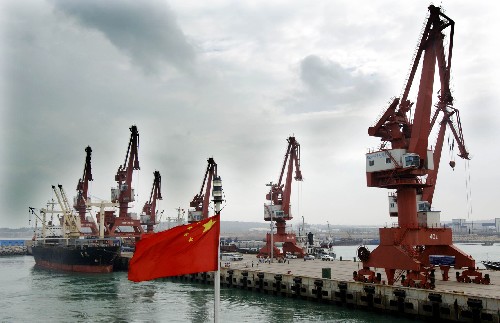The Chinese government has approved plans for the country's
fourth harbor area with preferential tax rates in a major step
towards a free trade zone with the Association of Southeast Asian
Nations (ASEAN).
The State Council authorized the Yangpu Bonded Harbor Area in
the Yangpu Economic Development Zone, south China's Hainan Province, covering 9.21 sq km and to be
completed in three stages.
The first phase of construction had already started, said Hainan
Vice Governor Jiang Sixian.
Fifty billion yuan will be spent on construction and the area
will host industries with a total output value of 100 billion yuan,
generating 12 billion yuan in taxes annually by 2012.

Three other bonded harbor areas are located in Yangshan of
Shanghai, Dongjiang of Tianjin and Dayaowan of Dalian, Liaoning
Province.
Yangpu Economic Development Zone is on the 150-sq-km Yangpu
Peninsula in northwestern Hainan, 40 km north of the provincial
capital, Haikou, and covers 30 sq. km..
Established in 1992, the zone was originally planned as an
export-oriented industrial district focusing on advanced technology
and the development of tertiary industry.
The 1997 Asian financial crisis, however, had a negative impact
on Yangpu from which it never fully recovered.
To attract overseas investors, the Yangpu Economic Development
Zone has been allowed to apply preferential policies.
Li Lanxue, chief of Haikou Customs, said the Yangpu Bonded
Harbor Area would offer tax breaks on imports, and rebates on
China-made commodities, while trade between companies inside the
harbor area would be exempt from value added and consumption taxes,
in addition to preferential policies granted to Yangpu Economic
Development Zone.
The establishment of the Yangpu Bonded Harbor Area was important
to regional economic development and energy strategies, said Jiang
Sixian. "This will help to advance economic development of this
province and of the Beibu Gulf between Hainan and ASEAN member
states."
Yangpu bonded harbor area bordered the ASEAN trading zone, close
to key international shipping routes, and had a deep-water
shoreline of more than 50 km where 80 berths with
dead-weight-tonnages of up to 300,000 tons could be built, said
Jiang.
It would be the closest industrial base to the oil and gas
resources in the South China Sea.
"Yangpu bonded harbor area will be built into the most open
shipping center on the Beibu Gulf, and a logistics center for
bonded and transit services in petroleum, gas, raw materials for
the chemical industry, pulp, paper products," said Jiang.
"Yangpu bonded harbor area, now a large petrochemical production
base, will become an important international base for processing
and export of petrochemical commodities," Jiang added.
China and ASEAN are seeking to establish a free trade area by
2010.
Since July 2005, China, Brunei, Malaysia, Indonesia, Myanmar,
Singapore and Thailand have cut tariffs on more than 7,000 items in
compliance with the Trade in Goods Agreement of a Framework
Agreement for Overall Economic Cooperation between China and the
ten ASEAN member states.
By 2010, China and Brunei, Indonesia, Malaysia, the Philippines,
Singapore and Thailand, will impose zero tariffs on most products,
while China and the four newer ASEAN members of Cambodia, the Laos,
Myanmar and Vietnam will do the same in 2015.
The China-ASEAN free trade area has a population of 1.8 billion
and US$2 trillion in gross domestic product (GDP). It will become
the third largest global trading region after the European Union
and the North America Free Trade Zone.
(Xinhua News Agency October 12, 2007)